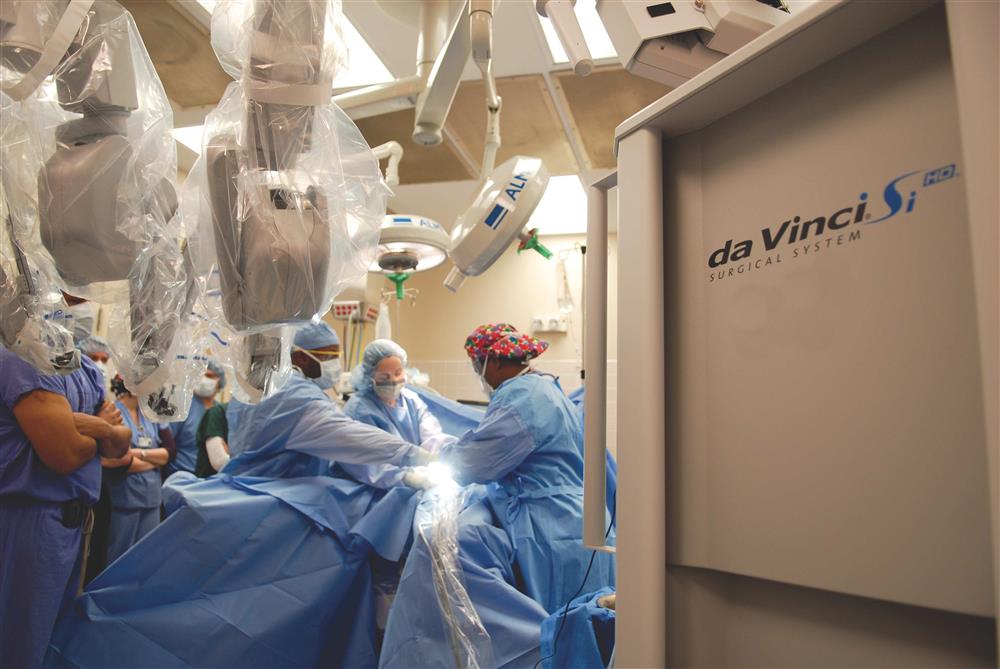State-of-the-art robotic surgery offers glimpse at UMMC's future

The recent launch of robotic surgery at the University of Mississippi Medical Center is expected to increase opportunities for learning, research and improved patient care.
The Medical Center acquired the da Vinci Si High Definition Surgical System, the latest in robotic-assisted minimally invasive surgery technology. The upgraded system, which debuted in April 2009, has enhanced three-dimensional HD resolution to provide physicians with a magnified view of the surgical field. Camera lenses magnify objects 10 times and in 3DHD.
A dual console helps with hands-on resident education.
"Residents will be able to pick up on the procedures more quickly," said Dr. Chad Huckabay, who joined the Medical Center in February as an assistant professor of surgery. He specializes in minimally invasive and robotic urologic surgery.
The da Vinci is mainly used for prostatectomies and gynecologic procedures, Huckabay said, but he added robotic surgery also has been used for kidney removal, tumor removal, lymph node dissections and ureteral blockages.
About four years ago, 60 percent of prostatectomies were done with robotic surgery. This year, that percentage is expected to jump to 80 percent, Huckabay said. Why?
Patient-driven requests fueled by knowledge of the benefits of robotic surgery is the main reason for the increase, said Huckabay. In cases of prostate removal, a smaller scar is appealing: a 1.5-inch incision compared to a 6-7-inch incision. "It's much closer to a scarless procedure cosmetically," he said. "People can return to normal activity three weeks after surgery."
Huckabay reassures patients that the surgeon has full control of the instruments and the camera during robotic procedures. Technological advancements provide surgeons with better precision but they can't replace physicians.
"Every movement of the robot is directed by movement of the surgeon. It enhances the motion of the surgeon. It's precise," Huckabay said.
Dr. Amber Shiflett, assistant professor of obstetrics and gynecology, was the first physician to use the Medical Center's da Vinci for a hysterectomy. She said better mobility for the surgeon is an important advantage of robotic surgery compared to laparoscopic surgery.
"The main difference is a 3D view of the pelvis, which is phenomenal. You mimic more of having your hands in the pelvis. You actually get more movement and retraction of the instruments with the robot," Shiflett said.
She said some people thought the robotic surgery would be longer, but she and fellow ob-gyns Dr. Jermaine Gray and Dr. Meredith Griffin have discovered that it's taking less time than a total laparoscopic hysterectomy.
Traditional open gynecologic surgery using a large incision had been the standard approach to many gynecologic procedures such as hysterectomies; but this can cause significant pain and a long recovery. Laparoscopic surgery was the next less-invasive procedure, and robotic surgery puts even better laparoscopic control in surgeons' hands.
Through robotic surgery, many complex gynecologic surgeries can now be treated effectively with a few tiny incisions, so patients can get back to life. Cowan said research opportunities could be developed to evaluate quality-of-life issues, such as patient experiences and cost comparisons.
Also, the popularity of robotic surgery impacts resident recruitment, Cowan said. When residents consider programs, one of the main questions is how they will be trained for robotic surgery.
"The wonderful thing about the dual console is, you as the attending can sit down with the resident at the other console. You can 'hand-off' instruments, and in difficult cases, the attending can take control of the instruments at any time," Shiflett said.
"In the next five years, you're going to see gynecology as the lead user of the machine," said Dr. Bryan Cowan, professor of obstetrics and gynecology. "Gynecology is changing. We're moving into the ambulatory environment."
Cowan said that's mainly because robotic surgery is less invasive. Benefits to patients include shorter hospital stays, quicker recovery times, less blood loss and fewer incisions for minimal scarring.
Dr. Scott Stringer, associate vice chancellor for clinical affairs, said the robotic system adds to University of Mississippi Health Care's goal of becoming a national leader in quality.
"The availability of the da Vinci robot will allow our surgeons to provide cutting-edge care to our patients on par with the most advanced health-care organizations in the nation," he said.


